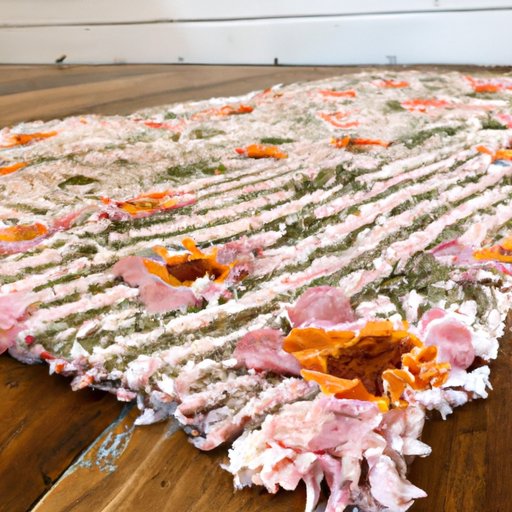
I. Introduction
A rag rug is a type of home decor item made by weaving together strips of fabric. It is a timeless and eco-friendly addition to any home, as it makes use of upcycled materials and reduces waste from textile consumption. This article aims to provide a detailed guide on how to make a rag rug, as well as tips and tricks on how to make it a one-of-a-kind piece.
II. Step-by-Step Guide: How to Make a Rag Rug
To make a rag rug, you will need a few basic tools and materials, including:
- Scissors
- Ruler or measuring tape
- Pen or marker
- Fabric strips (e.g. cotton, wool, silk or denim)
- Rug backing material
- A sewing machine or needle and thread
Next, follow these steps:
- Cut your fabric strips into even lengths. The width and length of the strips will depend on your desired rug size and thickness.
- Prepare your rug backing material by measuring it to the desired size and cutting it to fit.
- Sew or tie the fabric strips together, making sure they are tightly secured.
- Starting in the center of the rug, begin weaving the fabric strips through the holes of the backing material.
- Once you have completed a row, push the fabric strips tightly together to create a dense weave.
- Repeat the weaving process until you reach the edges of the rug.
- Cut any excess fabric strips and secure the ends with a knot or a stitch.
Remember to keep your weaving tight to create a sturdy and durable rug.
III. Incorporating Unique Designs
Rag rugs don’t have to be boring or plain. To make your rug stand out, consider incorporating unique designs and patterns.
- Try using fabrics in different colors and textures to create a multi-dimensional rug.
- Use different patterns, such as stripes or chevron, to add visual interest to your rug.
- Experiment with different weaving techniques, such as braiding or knotting, to give your rug a unique look and feel.
IV. Using Different Materials
There are different materials you can use to make a rag rug, and each material requires a different approach and technique. Here are some commonly used materials:
- Cotton: This fabric is easy to cut and weave, making it perfect for beginners.
- Wool: This material creates a thick and cozy rug, perfect for colder seasons.
- Silk: This material has a shiny and luxurious appeal, perfect for adding elegance and sophistication to any room.
- Denim: This sturdy and durable material can create a rustic and casual look and feel.
When working with different materials, it’s important to adjust your weaving technique and thread tension accordingly. You may also need to use a different needle or thread depending on the fabric’s thickness.
V. Making Rag Rugs for Different Purposes
Rag rugs can serve different purposes in your home, ranging from decorative to functional. Here are some ideas:
- Doormats: Use sturdy and durable fabric to create a long-lasting doormat.
- Pet beds: Use soft and cozy fabric to make a comfortable bed for your furry friend.
- Wall hangings: Use colorful fabrics and unique patterns to create a statement wall hanging.
Different purposes may require different sizes, shapes, and thicknesses. Consider your intended use before starting your project.
VI. Upcycling Old Fabrics
Upcycling old fabrics is not only good for the environment but can also add sentimental value to your rug. Here are some ways to upcycle old fabrics:
- Use old T-shirts or sweaters to create a cozy and personalized rug.
- Use leftover fabric from previous projects to create a patchwork rug.
- Use old jeans to create a denim rug.
When choosing fabrics to upcycle, make sure they are clean, free of holes, and similar in thickness. You can also mix and match fabrics to create a one-of-a-kind rug.
VII. Conclusion
Now that you have all the essential tools, techniques, and tips to create a rag rug, it’s time to start your project. Remember to take your time, experiment with different designs and patterns, and use upcycled fabrics to make it a sustainable and unique addition to your home decor.




